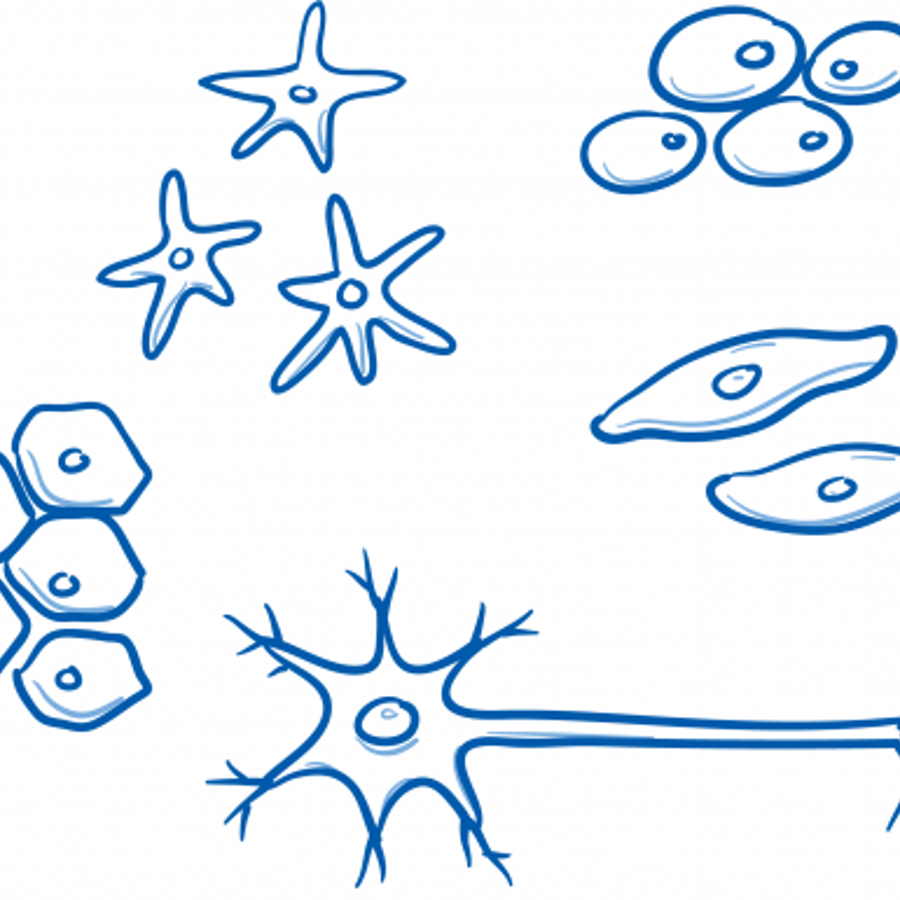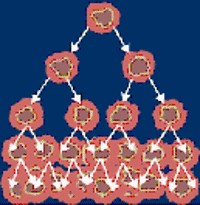
How can two drastically different cell types share the same genes?
March 1, 2011

- Related Topics:
- Developmental biology,
- Epigenetics,
- DNA basics,
- Genes to proteins
An undergraduate from Michigan asks:
"How can two drastically different cell types share the same genes?"
It sounds like you are already well aware of the fact that every cell in our body has the same set of genes. This is because all of the cells in our bodies start from a single fertilized egg.
That first cell divided over and over again until a new baby was made. In the end, we all are made up of trillions of cells with nearly identical genes*.

And yet, all cells are obviously not the same. It is easy to see that the cells in our heart, for instance, work very differently from the cells in our eyes. The same is true for our skin and our liver cells. Or our brain and muscle cells. Or any of the other 300 or so different cell types.
These cells are different because they use the same set of genes differently. So even though each of our cells has the same 20,000 or so genes, each cell can select which ones it wants to "turn on" and which ones it wants to keep "turned off".
It might help to think about our set of genes as a cookbook and each of our cell types as a different cook. So the breakfast cook focuses only on breakfast recipes and the lunch chef only on lunch ones. Just like our heart cells focus on heart genes and our eye cells on eye genes.
Of course our genes aren't recipes for blueberry pancakes or minestrone soup. Instead, they are actually recipes for proteins.
Genes are like Recipes for Proteins
Genes are recipes that provide instructions that make us who we are. They determine what we look like and help our body to grow and function properly.
Just like a chef reads a recipe to make a dish, cells read a gene to make a protein. Each gene makes a specific protein that does a specific job.

So one protein might let us tell red from green and another one might be part of the system to make a heart beat. And so on for all 20,000 of our genes. Cells need to make thousands of different proteins in the right amounts, at the right time, and in the right place in order to work properly.
Again this is like a chef. The chef needs to use the right recipes in the right amounts at the right time to make a meal work. First the appetizers, then the main course, and finally the dessert--all to feed the right number of people.
It would obviously be a mess if the chef served everything all at once in a big bucket. Same thing with a cell. Who wants their heart to tell red from green? Or their eyes to pump?
Not only would this be a bit creepy, but it could be bad for you. Your body would be wasting energy making proteins in places where those proteins aren't needed. And it could be downright dangerous!
For example, early on our cells need to divide and divide so we can grow from one to trillions of cells. All of our cells have the growth genes churning our proteins to make the cells keep dividing. But when we are done growing, we don't want our cells to keep dividing. These genes stop making proteins and cells stop dividing so much. If the cells didn't stop growing, this growth would cause cancer.
So when everything is working OK, each cell type only reads the genes it needs. That way it only makes the proteins it needs too.
That is how cell types can be so different even though they have the same set of genes. The set of genes we have has the instructions for everything about us. Each cell type just picks and chooses the recipes it wants to use. Like a chef.
*Some exceptions to the rule are:
- Gametes (sperm and egg cells) have only half of the amount of DNA
- B cells in our immune system have some DNA that is rearranged in order to make antibodies
- Mature red blood cells have no DNA

Author: Kim Vande Wydeven
When this answer was published in 2011, Kim was a student in the Stanford MS Program in Human Genetics and Genetic Counseling. Kim wrote this answer while participating in the Stanford at The Tech program.
 Skip Navigation
Skip Navigation
